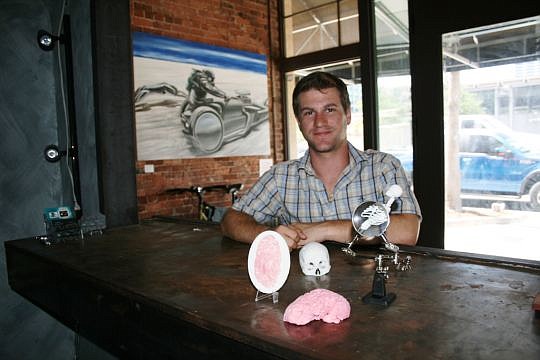
Josh Weinberger hasn’t been a model law student.
But the 24-year-old Jacksonville man is creating models that could help lawyers win in the courtroom.
“It’s a new way of bringing evidence to life,” the former Stetson University College of Law student said of his business, 3-D Printed Evidence.
Using models in the courtroom isn’t new. Attorneys realized long ago jurors can glean more from a cardboard replica of a crime scene or a cast of a footprint, for example, than from photographs.
But the exactness of 3-D printed technology provides more detail, accuracy and perspective than many other types of replicas.
“If a picture says a thousand words, then a model says a lot more. That’s especially the case with 3-D models,” Weinberger said at the Downtown Jacksonville office of his 3-D business partner, Forge.
Since 3-D Printed Evidence was conceived last fall, Weinberger has assisted with a handful of legal cases, though none locally.
His first project was a model of a fractured skull for a St. Petersburg law firm that learned about 3-D Printed Evidence from an American Bar Association publication.
It was the first time Weinberger used data from an MRI to produce a model.
“They could have shown the fracture on a screen, but the model solidified to the jury just how bad the injury was,” he said.
Weinberger’s latest project is replicating an abscess that his client said should have been discovered by physicians.
“The doctor said it’s the largest abscess he’s ever seen,” Weinberger said of the Alabama case.
A Kissimmee native, Weinberger is the son of a medical doctor and an attorney, and the stepson of a retired federal judge. His sister recently joined his mother’s law firm.
“Practicing law is almost inevitable,” he said.
But law school began inauspiciously for Weinberger. He was forced from the classroom for two years after flunking a course in his second semester at Stetson.
Aiming to re-enter law school in fall 2016, Weinberger began a Forge internship last fall.
One of his first jobs was for a Maryland forensics instructor who wanted to replicate a bullet entering and exiting a wall.
“I got to thinking: why not use 3-D printing in medical malpractice and in litigation in general, especially with today’s scanning capabilities?” he said.
3-D Printed Evidence was quickly created as an alliance of Weinberger’s interests and Forge’s expertise, said Forge co-founder, Bryce Pfanenstiel.
“The creative potential of our industry is overwhelming at first, so it helps to provide some direction to newcomers and support their technical needs,” Pfanenstiel said.
Before venturing with Forge, Weinberger did not have experience with graphic arts; rather, he was driven to the Forge collaboration by his interest in intellectual property, copyright and patent disputes.
“3-D printing and the law have always been strange bed partners, from Cody Wilson’s 3-D printed gun to an array of intellectual property disputes,” Weinberger said.
Wilson is a gun-rights activist whose organization, Defense Distributed, publishes designs of working plastic guns that can be downloaded and reproduced by anyone with a 3-D printer.
Indeed, Weinberger said he’s particularly intrigued by the testy relationship between 3-D printing and intellectual property rights.
While there are numerous ways to violate intellectual property rights — copyrights, patents and trademarks — the proverbial jury is out regarding the repercussions of using 3-D printers.
“3-D printers do not take away intellectual property rights any more than computers grant them,” Weinberger said. “But they do provide an opportunity for people to re-examine old assumptions about how the system works.”
Weinberger said that while medical malpractice attorneys can particularly benefit from his work, demonstrating injuries in vehicular crashes may ultimately be his most significant niche.
“I think that is the highest potential because when you are showing the jurors a model, you are showing them something that is real. 3-D evidence gives jurors the advantage of tactile perception — it’s something they can see and feel,” he said.
To further market his business, Weinberger intends to exhibit at Bar association and other events, including a national trial lawyer conference. He showcased his work at Jacksonville’s One Spark, which he said was only mildly successful for him because the audience was not targeted enough.
He concedes he has much to learn.
Weinberger said he and a client were particularly pleased with a model he recently built to demonstrate the gradient levels of a Houston neighborhood. The area is the subject of a civil dispute due to flooding in the area.
“Really, that topographical model just shows that the potential with 3-D Printed Evidence is unlimited,” he said.
Pfanenstiel agrees.
“I believe Josh is in a position to become a leader in the evidentiary model industry as it develops,” he said.